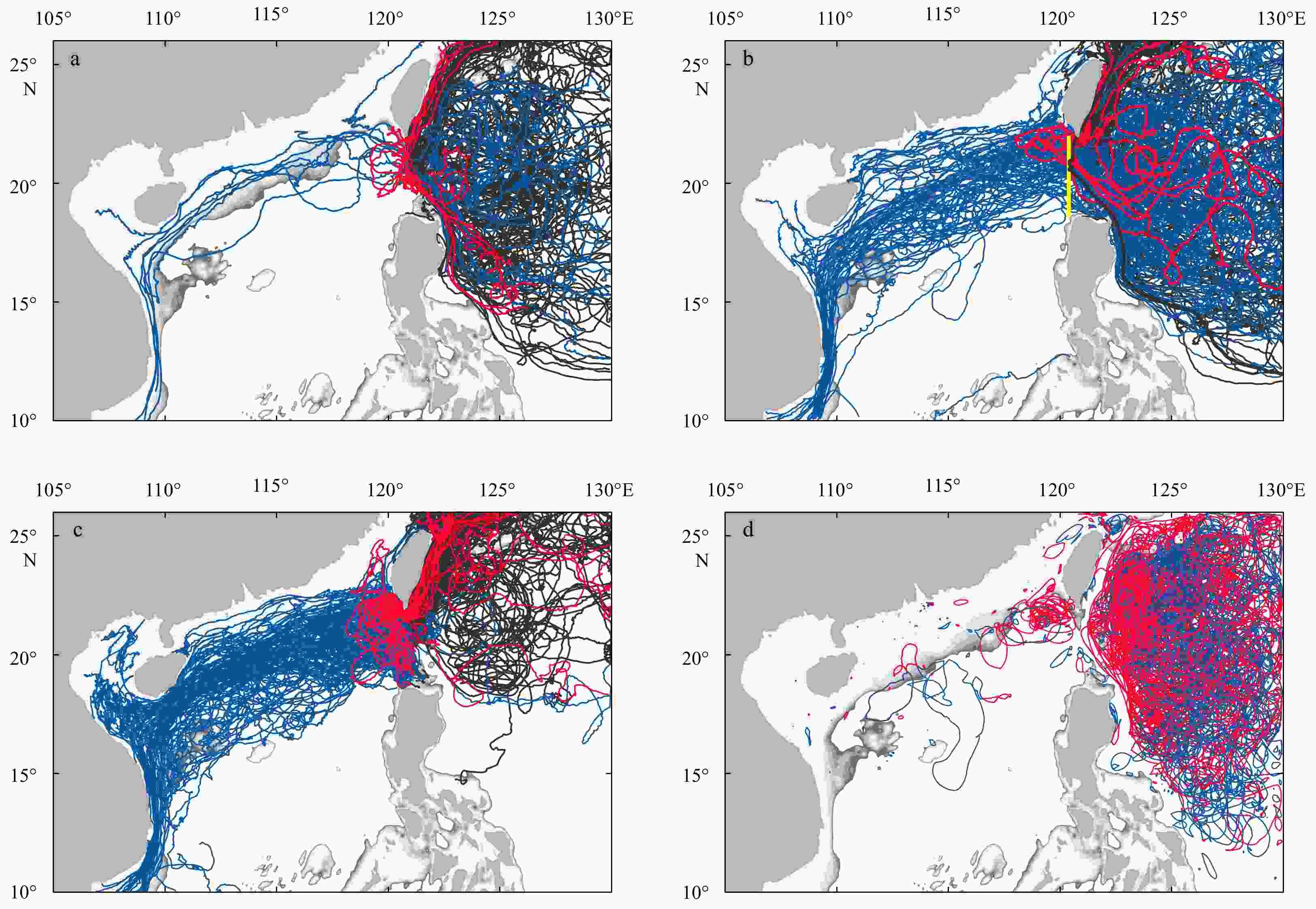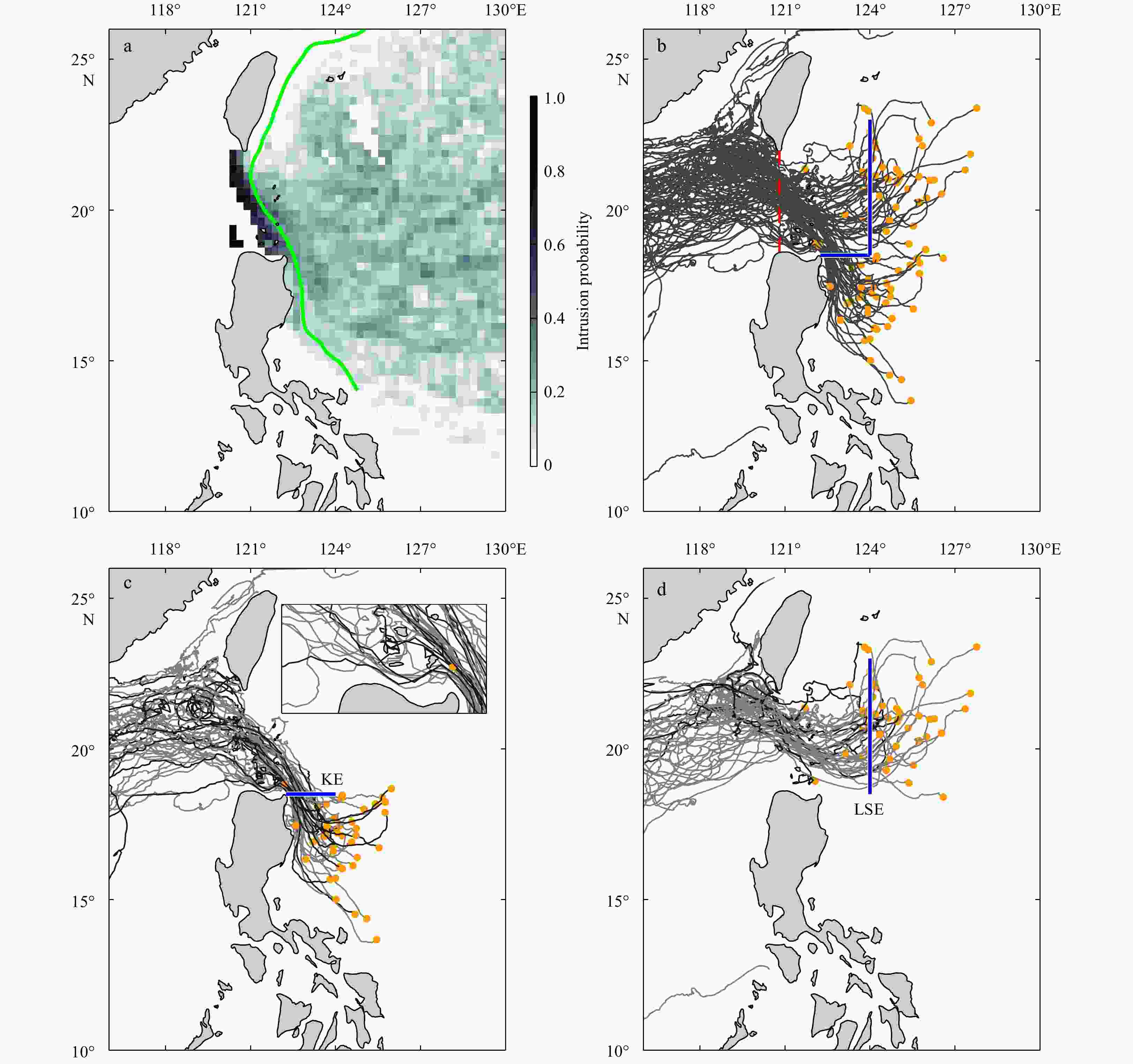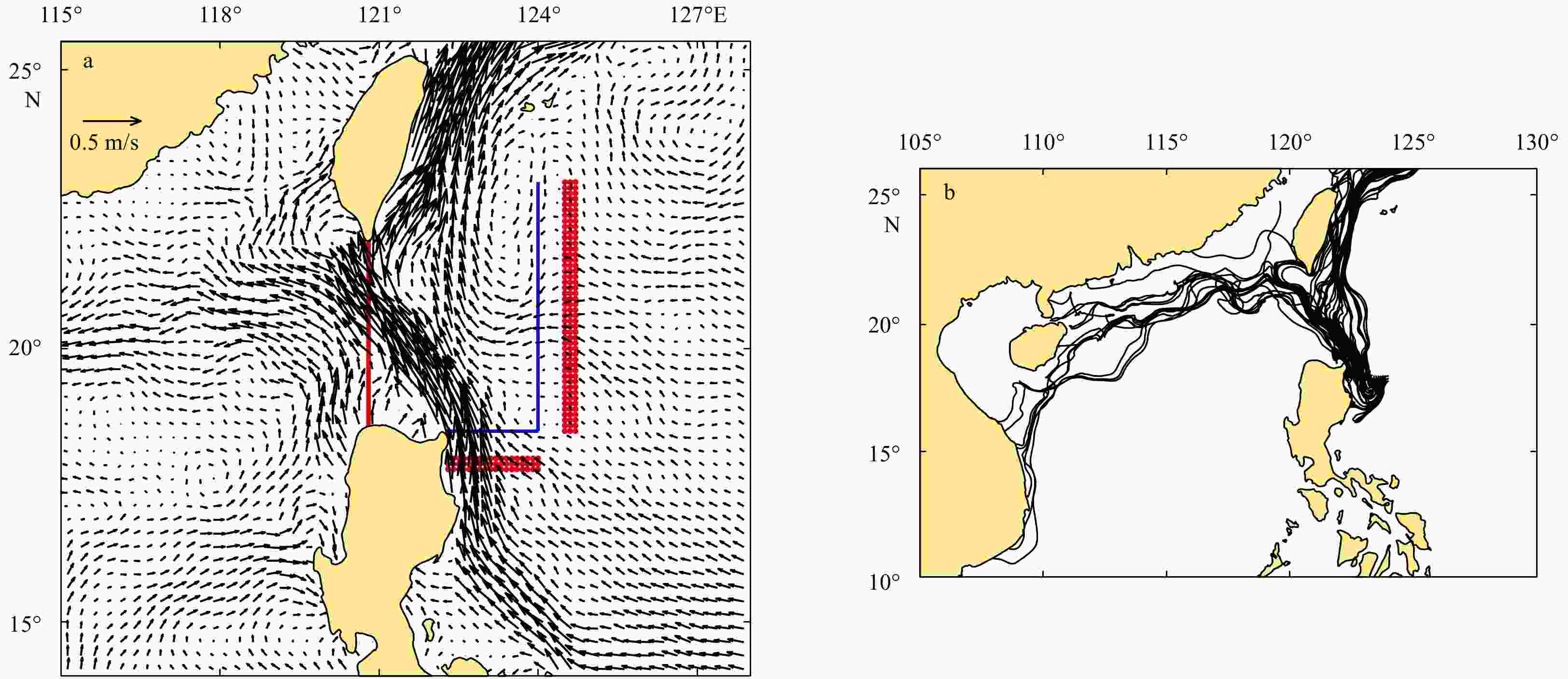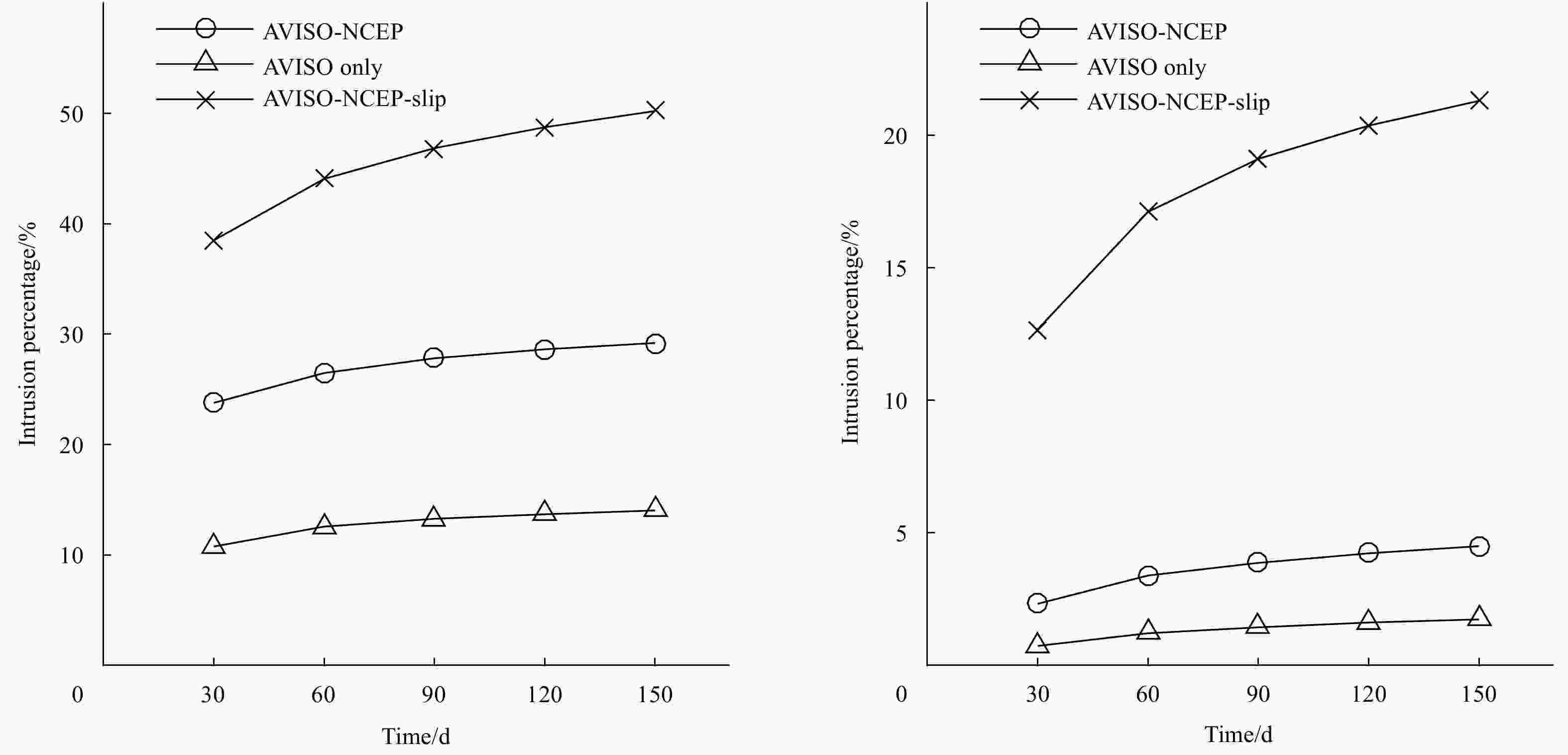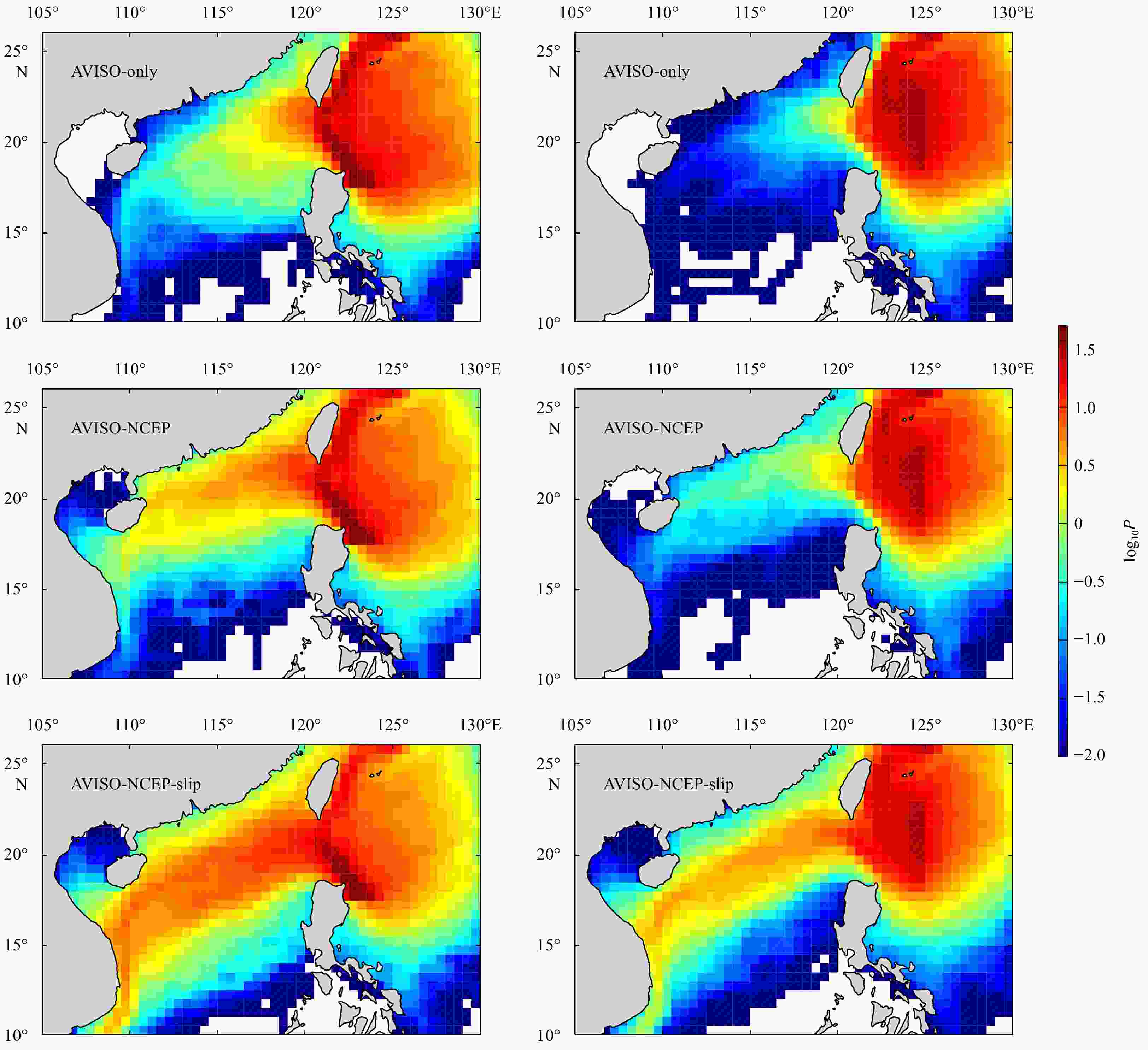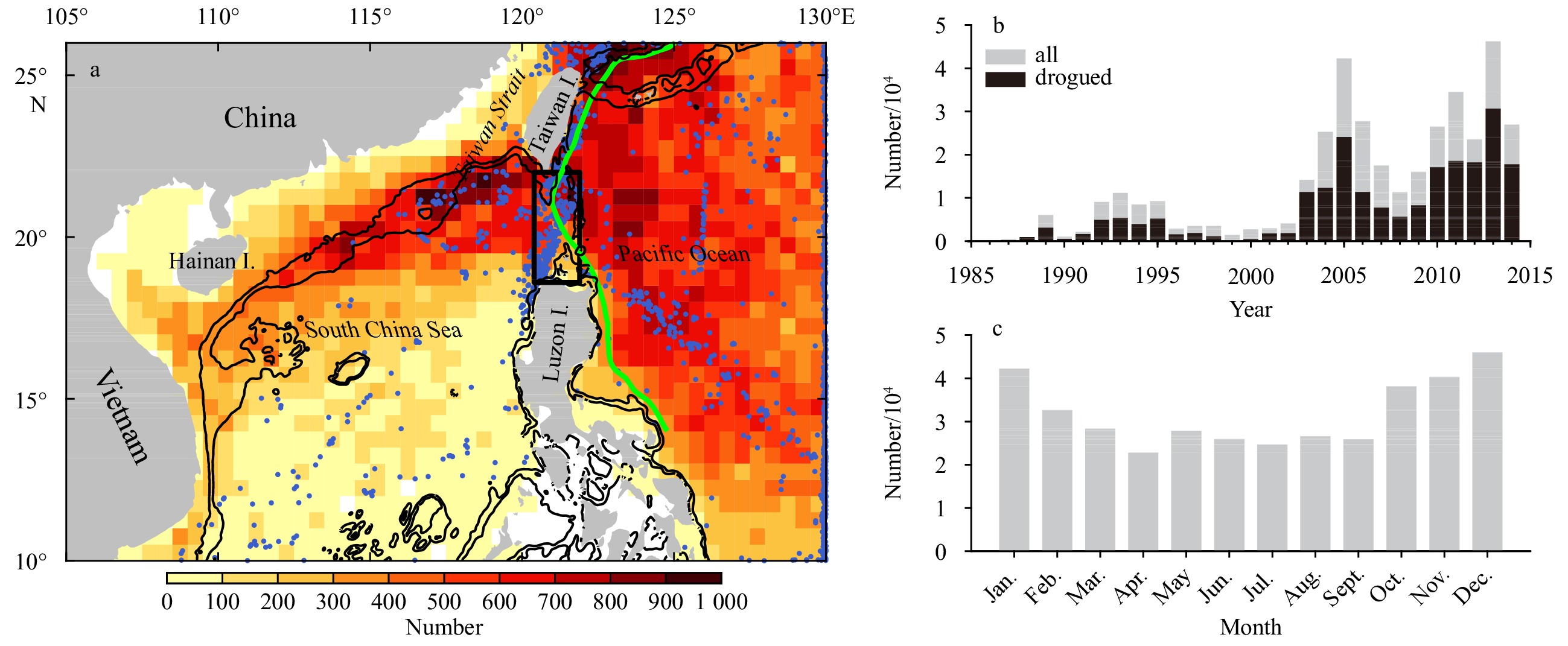A Lagrangian study of the near-surface intrusion of Pacific water into the South China Sea
-
Abstract: Satellite-tracked Lagrangian drifters are used to investigate the transport pathways of near-surface water around the Luzon Strait. Particular attention is paid to the intrusion of Pacific water into the South China Sea (SCS). Results from drifter observations suggest that except for the Kuroshio water, other Pacific water that carried by zonal jets, Ekman currents or eddies, can also intrude into the SCS. Motivated by this origin problem of the intrusion water, numerous simulated trajectories are constructed by altimeter-based velocities. Quantitative estimates from simulated trajectories suggest that the contribution of other Pacific water to the total intrusion flux in the Luzon Strait is approximately 13% on average, much smaller than that of Kuroshio water. Even so, over multiple years and many individual intrusion events, the contribution from other Pacific water is quite considerable. The interannual signal in the intrusion flux of these Pacific water might be closely related to variations in a wintertime westward current and eddy activities east of the Luzon Strait. We also found that Ekman drift could significantly contribute to the intrusion of Pacific water and could affect the spreading of intrusion water in the SCS. A case study of an eddy-related intrusion is presented to show the detailed processes of the intrusion of Pacific water and the eddy-Kuroshio interaction.
-
Key words:
- Kuroshio intrusion /
- Lagrangian transport /
- Luzon Strait /
- South China Sea
-
Figure 1. Geographic distributions of the number of drifter observations in each 0.5°×0.5° bin between 1986 and 2014 (a), the total number of drifter observations (gray) in each year (b), the total number of drifter observations (gray) in each month (c). In a, the blue dots indicate the locations where the drifters were launched or drifted in. The black box outlines the Luzon Strait (18.6°–22.0°N, 120.4°–121.9°E). The green line approximates the mean Kuroshio core based on AVISO velocities. The black contours are 200 m and 1000 m isobaths. In b, the black bars denote the number of drogued drifters.
Figure 2. Selected drifter trajectories near the Luzon Strait. a and b. Trajectories of drifters that originated from the Pacific Ocean and reached the Luzon Strait from April–September and October–March; c. trajectories of drifters launched inside the Luzon Strait; and d. trajectories of cyclonic (blue) and anticyclonic (red) closed loops identified from drifters originating in the Pacific Ocean. Based on the different fates and the ways leaving the Luzon Strait, drifters in a–c are grouped into three types: those directly drifted into the SCS (blue), into the western Pacific after looping into the SCS (red), and into the western Pacific with no loop in the SCS (black). In b, the bold black line denotes the trajectory of the drifter with ID 7710570 and the yellow line denotes the western boundary of the strait. The bottom topography from 0 m to 1 000 m is shaded in gray with contour intervals of 200 m.
Figure 3. Seasonal cycles of quasi-Eulerian velocity fields (vectors) derived from the drifter observations. a. January–March, b. April–June, c. July–September, and d. October–December. The colors present the number of the 7-d observation windows in each 0.5°×0.5° bin. Note that the velocities were estimated only for bins with more than five 7-d observation windows.
Figure 4. The intrusion of Pacific water into the SCS. a. Intrusion probability map with 0.25°×0.25° bins. The green curve approximates the mean Kuroshio core. b. Trajectories of intrusion drifters 15 d before and after crossing the line 120.8°E (the red dash line) in the Luzon Strait. Yellow dots denote the initial positions of these trajectories. The zonal and meridional blue lines denote the KC and LSE section, respectively. c. A subset of trajectories across the KC section (18.5°N, 122.3°–124.0°E). d. A subset of trajectories across the LSE section (124.0°E, 18.5°N–23.0°N). In c and d, trajectories of drogued and undrogued drifters are marked in dark grey and grey, respectively.
Figure 6. Schematic plot for release locations of three different groups of simulated particles (a, red dots), and a subset of 150-d trajectories of 54 particles released from the KC band and advected within the AVISO-NCEP velocity field (b). In a, the zonal and meridional blue lines denote the KC (18.5°N, 122.3°–124.0°E) and LSE (18.5°–23.0°N, 124.0°E) section, respectively. The average AVISO-NCEP velocity field is superimposed.
-
[1] Brambilla E, Talley L D. 2006. Surface drifter exchange between the North Atlantic subtropical and subpolar gyres. Journal of Geophysical Research, 111(C7): C07026 [2] Cai Shuqun, Liu Hailong, Li Wei, et al. 2005. Application of LICOM to the numerical study of the water exchange between the South China Sea and its adjacent oceans. Acta Oceanologica Sinica, 24(4): 10–19 [3] Caruso M J, Gawarkiewicz G G, Beardsley R C. 2006. Interannual variability of the Kuroshio intrusion in the South China Sea. Journal of Oceanography, 62(4): 559–575. doi: 10.1007/s10872-006-0076-0 [4] Centurioni L R, Niiler P P, Lee D K. 2004. Observations of inflow of Philippine sea surface water into the South China Sea through the Luzon Strait. Journal of Physical Oceanography, 34(1): 113–121. doi: 10.1175/1520-0485(2004)034<0113:OOIOPS>2.0.CO;2 [5] Centurioni L R, Ohlmann J C, Niiler P P. 2008. Permanent meanders in the California current system. Journal of Physical Oceanography, 38(8): 1690–1710. doi: 10.1175/2008JPO3746.1 [6] Chang Yulin, Miyazawa Y, Guo Xinyu. 2015. Effects of the STCC eddies on the Kuroshio based on the 20-year JCOPE2 reanalysis results. Progress in Oceanography, 135: 64–76. doi: 10.1016/j.pocean.2015.04.006 [7] Chang Yulin, Oey L Y. 2012. The Philippines-Taiwan oscillation: monsoonlike interannual oscillation of the subtropical-tropical western north pacific wind system and its impact on the ocean. Journal of Climate, 25(5): 1597–1618. doi: 10.1175/JCLI-D-11-00158.1 [8] Farris A, Wimbush M. 1996. Wind-induced Kuroshio intrusion into the South China Sea. Journal of Oceanography, 52(6): 771–784. doi: 10.1007/BF02239465 [9] Guo Jingsong, Chen Xianyao, Sprintall J, et al. 2012. Surface inflow into the South China Sea through the Luzon Strait in winter. Chinese Journal of Oceanology and Limnology, 30(1): 163–168. doi: 10.1007/s00343-012-1056-4 [10] Hansen D V, Poulain P M. 1996. Quality control and interpolations of WOCE-TOGA drifter data. Journal of Atmospheric and Oceanic Technology, 13(4): 900–909. doi: 10.1175/1520-0426(1996)013<0900:QCAIOW>2.0.CO;2 [11] He Qingyou, Zhan Haigang, Cai Shuqun, et al. 2016. Eddy effects on surface chlorophyll in the northern South China Sea: mechanism investigation and temporal variability analysis. Deep Sea Research Part I: Oceanographic Research Papers, 112: 25–36. doi: 10.1016/j.dsr.2016.03.004 [12] Huang Bangqin, Hu Jun, Xu Hongzhou, et al. 2010. Phytoplankton community at warm eddies in the northern South China Sea in winter 2003/2004. Deep Sea Research Part II: Topical Studies in Oceanography, 57(19–20): 1792–1798. doi: 10.1016/j.dsr2.2010.04.005 [13] Huang Zhida, Liu Hailong, Hu Jianyu, et al. 2016. A double-index method to classify Kuroshio intrusion paths in the Luzon Strait. Advances in Atmospheric Sciences, 33(6): 715–729. doi: 10.1007/s00376-015-5171-y [14] Jia Yinglai, Chassignet E P. 2011. Seasonal variation of eddy shedding from the Kuroshio intrusion in the Luzon Strait. Journal of Oceanography, 67(5): 601–611. doi: 10.1007/s10872-011-0060-1 [15] Jia Yinglai, Liu Qinyu. 2004. Eddy Shedding from the Kuroshio Bend at Luzon Strait. Journal of Oceanography, 60(6): 1063–1069. doi: 10.1007/s10872-005-0014-6 [16] Kim Y Y, Qu Tangdong, Jensen T, et al. 2004. Seasonal and interannual variations of the North Equatorial Current bifurcation in a high-resolution OGCM. Journal of Geophysical Research, 109(C3): C03040 [17] LaCasce J H. 2008. Statistics from Lagrangian observations. Progress in Oceanography, 77(1): 1–29. doi: 10.1016/j.pocean.2008.02.002 [18] Large W G, Pond S. 1982. Sensible and latent heat flux measurements over the ocean. Journal of Physical Oceanography, 12(5): 464–482. doi: 10.1175/1520-0485(1982)012<0464:SALHFM>2.0.CO;2 [19] Laurindo L C, Mariano A J, Lumpkin R. 2017. An improved near-surface velocity climatology for the global ocean from drifter observations. Deep Sea Research Part I: Oceanographic Research Papers, 124: 73–92. doi: 10.1016/j.dsr.2017.04.009 [20] Lee D K, Centurioni L R. 2013. The wintertime subtropical current in the Northwestern Pacific. Oceanography, 26(1): 28–37. doi: 10.5670/oceanog.2013.02 [21] Li Li, Wu Boyu. 1989. A Kuroshio loop in South China Sea? —On circulations of the northeastern South China Sea. Journal of Oceanography in Taiwan Strait (in Chinese), 8(1): 89–95 [22] Li Jiaxun, Zhang Ren, Jin Baogang. 2011. Eddy characteristics in the northern South China Sea as inferred from Lagrangian drifter data. Ocean Science, 7(5): 661–669. doi: 10.5194/os-7-661-2011 [23] Liang W D, Yang Y J, Tang T Y, et al. 2008. Kuroshio in the Luzon Strait. Journal of Geophysical Research, 113(C8): C08048 [24] Lien R C, Ma B, Cheng Y H, et al. 2014. Modulation of Kuroshio transport by mesoscale eddies at the Luzon Strait entrance. Journal of Geophysical Research, 119(4): 2129–2142 [25] Liu Tongya, Xu Jiexin, He Yinghui, et al. 2016. Numerical simulation of the Kuroshio intrusion into the South China Sea by a passive tracer. Acta Oceanologica Sinica, 35(9): 1–12. doi: 10.1007/s13131-016-0930-x [26] Lu Jiuyou, Liu Qinyu. 2013. Gap-leaping Kuroshio and blocking westward-propagating Rossby wave and eddy in the Luzon Strait. Journal of Geophysical Research, 118(3): 1170–1181 [27] Lumpkin R, Özgökmen T, Centurioni L. 2017. Advances in the application of surface drifters. Annual Review of Marine Science, 9: 59–81. doi: 10.1146/annurev-marine-010816-060641 [28] Nan Feng, Xue Huijie, Chai Fei, et al. 2011a. Identification of different types of Kuroshio intrusion into the South China Sea. Ocean Dynamics, 61(9): 1291–1304. doi: 10.1007/s10236-011-0426-3 [29] Nan Feng, Xue Huijie, Xiu Peng, et al. 2011b. Oceanic eddy formation and propagation southwest of Taiwan. Journal of Geophysical Research, 116(C12): C12045. doi: 10.1029/2011JC007386 [30] Niiler P P, Maximenko N A, Panteleev G G, et al. 2003. Near-surface dynamical structure of the Kuroshio Extension. Journal of Geophysical Research, 108(C6): 3193. doi: 10.1029/2002JC001461 [31] Niiler P P, Sybrandy A S, Bi K N, et al. 1995. Measurements of the water-following capability of holey-sock and TRISTAR drifters. Deep Sea Research Part I: Oceanographic Research Papers, 42(11–12): 1951–1955. doi: 10.1016/0967-0637(95)00076-3 [32] Nitani H. 1972. Beginning of the Kuroshio. In: Stommel H, Yashida K, eds. Physical Aspects of the Japan Current. Seattle, USA: University of Washington Press, 129–163 [33] Pazan S E, Niiler P P. 2001. Recovery of near-surface velocity from undrogued drifters. Journal of Atmospheric and Oceanic Technology, 18(3): 476–489. doi: 10.1175/1520-0426(2001)018<0476:RONSVF>2.0.CO;2 [34] Peng Shiqiu, Qian Yukun, Lumpkin R, et al. 2015. Characteristics of the near-surface currents in the Indian Ocean as deduced from satellite-tracked surface drifters. Part I: Pseudo-Eulerian Statistics. Journal of Physical Oceanography, 45(2): 441–458. doi: 10.1175/JPO-D-14-0050.1 [35] Qian Yukun, Peng Shiqiu, Li Yineng. 2013. Eulerian and Lagrangian statistics in the South China Sea as deduced from surface drifters. Journal of Physical Oceanography, 43(4): 726–743. doi: 10.1175/JPO-D-12-0170.1 [36] Qiu Bo, Chen Shuiming. 2010. Interannual-to-decadal variability in the bifurcation of the north equatorial current off the Philippines. Journal of Physical Oceanography, 40(11): 2525–2538. doi: 10.1175/2010JPO4462.1 [37] Qu Tangdong, Kim Y Y, Yaremchuk M, et al. 2004. Can Luzon Strait transport play a role in conveying the impact of ENSO to the South China Sea?. Journal of Climate, 17(18): 3644–3657. doi: 10.1175/1520-0442(2004)017<3644:CLSTPA>2.0.CO;2 [38] Qu Tangdong, Mitsudera H, Yamagata T. 2000. Intrusion of the North Pacific waters into the South China Sea. Journal of Geophysical Research, 105(C3): 6415–6424. doi: 10.1029/1999JC900323 [39] Ralph E A, Niiler P P. 1999. Wind-driven currents in the tropical Pacific. Journal of Physical Oceanography, 29(9): 2121–2129. doi: 10.1175/1520-0485(1999)029<2121:WDCITT>2.0.CO;2 [40] Rudnick D L, Jan S, Centurioni L, et al. 2011. Seasonal and mesoscale variability of the Kuroshio near its origin. Oceanography, 24(4): 52–63. doi: 10.5670/oceanog.2011.94 [41] Rypina I I, Jayne S R, Yoshida S, et al. 2014. Drifter-based estimate of the 5 year dispersal of Fukushima-derived radionuclides. Journal of Geophysical Research, 119(11): 8177–8193 [42] Shaw P T. 1991. The seasonal variation of the intrusion of the Philippine sea water into the South China Sea. Journal of Geophysical Research, 96(C1): 821–827. doi: 10.1029/90JC02367 [43] Sheu W J, Wu C R, Oey L Y. 2010. Blocking and westward passage of eddies in the Luzon strait. Deep Sea Research Part II: Topical Studies in Oceanography, 57(19-20): 1783–1791. doi: 10.1016/j.dsr2.2010.04.004 [44] Sun Zhongbin, Zhang Zhiwei, Zhao Wei, et al. 2016. Interannual modulation of eddy kinetic energy in the northeastern South China Sea as revealed by an eddy-resolving OGCM. Journal of Geophysical Research, 121(5): 3190–3201 [45] Tian Jiwei, Yang Qingxuan, Liang Xinfeng, et al. 2006. Observation of Luzon Strait transport. Geophysical Research Letters, 33(19): L19607. doi: 10.1029/2006GL026272 [46] Trenberth K E, Large W G, Olson J G. 1989. The effective drag coefficient for evaluating wind stress over the oceans. Journal of Climate, 2(12): 1507–1516. doi: 10.1175/1520-0442(1989)002<1507:TEDCFE>2.0.CO;2 [47] van Sebille E, Sprintall J, Schwarzkopf F U, et al. 2014. Pacific-to-Indian ocean connectivity: Tasman leakage, Indonesian Throughflow, and the role of ENSO. Journal of Geophysical Research, 119(2): 1365–1382 [48] Wang Guihua, Wang Hui, Liu Zenghong, et al. 2008a. Observations of near surface current at the Luzon Strait in winter. Acta Oceanologica Sinica, 27(S1): 145–150 [49] Wang Guihua, Wang Dongxiao, Zhou Tianjun. 2012. Upper layer circulation in the Luzon Strait. Aquatic Ecosystem Health & Management, 15(1): 39–45 [50] Wang Dongxiao, Xu Hongzhou, Lin Jing, et al. 2008b. Anticyclonic eddies in the Northeastern South China Sea during Winter 2003/2004. Journal of Oceanography, 64(6): 925–935. doi: 10.1007/s10872-008-0076-3 [51] Wu C R. 2013. Interannual modulation of the Pacific Decadal Oscillation (PDO) on the low-latitude western North Pacific. Progress in Oceanography, 110: 49–58. doi: 10.1016/j.pocean.2012.12.001 [52] Yan Xiaomei, Zhu Xiaohua, Pang Chongguang, et al. 2016. Effects of mesoscale eddies on the volume transport and branch pattern of the Kuroshio east of Taiwan. Journal of Geophysical Research, 121(10): 7683–7700 [53] Yu Kai, Qu Tangdong. 2013. Imprint of the Pacific Decadal Oscillation on the South China Sea throughflow variability. Journal of Climate, 26(24): 9797–9805. doi: 10.1175/JCLI-D-12-00785.1 [54] Yuan Dongliang, Han Weiqing, Hu Dunxin. 2006. Surface Kuroshio path in the Luzon Strait area derived from satellite remote sensing data. Journal of Geophysical Research, 111(C11): C11007. doi: 10.1029/2005JC003412 [55] Yuan Dongliang, Wang Zheng. 2011. Hysteresis and dynamics of a western boundary current flowing by a gap forced by impingement of mesoscale eddies. Journal of Physical Oceanography, 41(5): 878–888. doi: 10.1175/2010JPO4489.1 [56] Zhang Zhiwei, Zhao Wei, Qiu Bo, et al. 2017. Anticyclonic eddy sheddings from Kuroshio loop and the accompanying cyclonic eddy in the northeastern South China Sea. Journal of Physical Oceanography, 47(6): 1243–1259. doi: 10.1175/JPO-D-16-0185.1 [57] Zhang Zhiwei, Zhao Wei, Tian Jiwei, et al. 2015. Spatial structure and temporal variability of the zonal flow in the Luzon Strait. Journal of Geophysical Research, 120(2): 759–776 [58] Zheng Quanan, Tai C K, Hu Jianyu, et al. 2011. Satellite altimeter observations of nonlinear Rossby eddy-Kuroshio interaction at the Luzon Strait. Journal of Oceanography, 67(4): 365–376. doi: 10.1007/s10872-011-0035-2 -




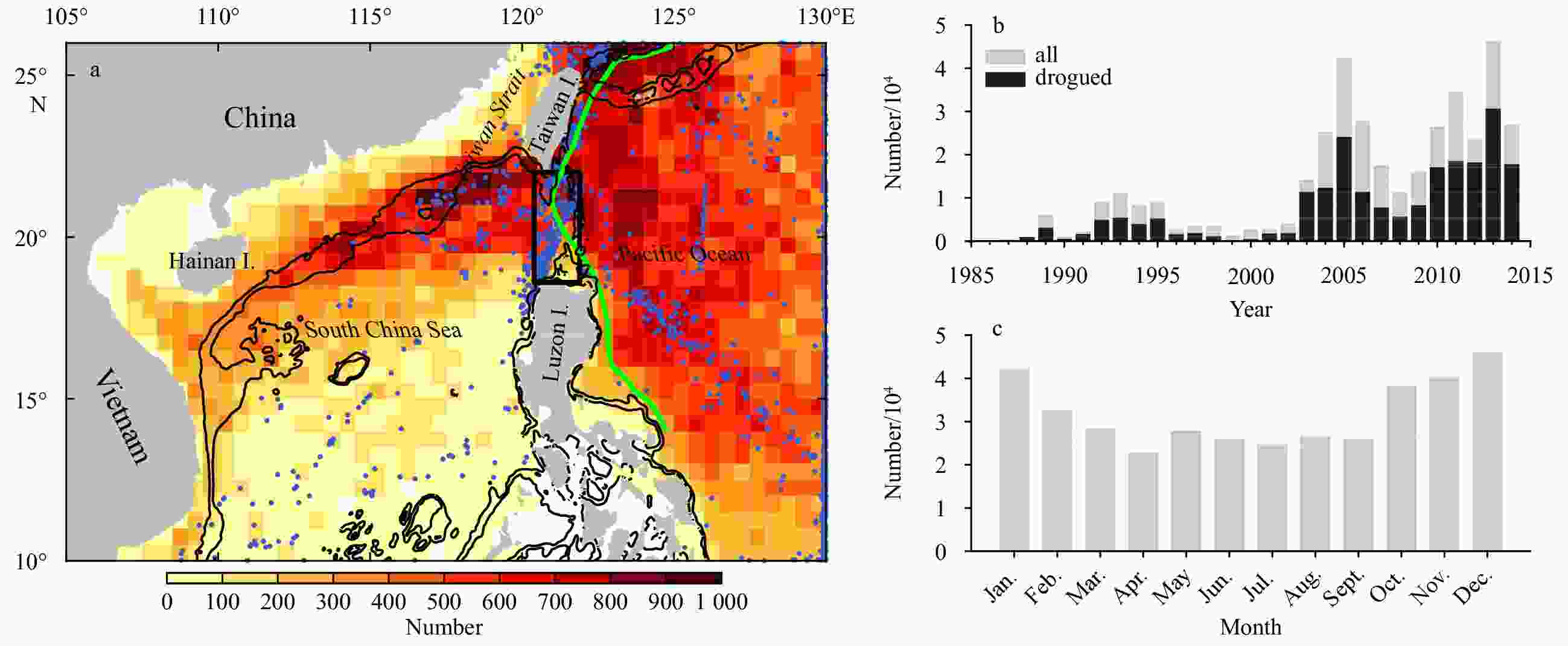
 下载:
下载:
